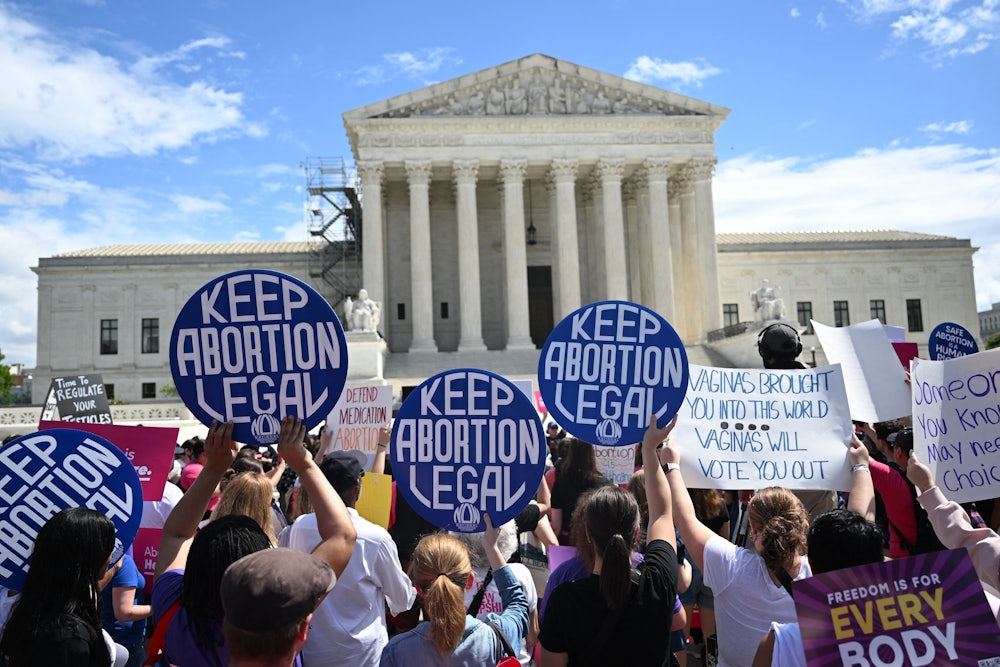Earlier this week, Ohio voters handed a major defeat to anti-abortion groups by rejecting a constitutional amendment that technically didn’t have anything to do with abortion. Issue 1 would have made it significantly harder for Ohioans to change their state constitution through the use of ballot referenda. The barely disguised subtext was that its approval would likely block an abortion-rights amendment that is set to be voted upon in November.
Voters decisively rejected that course of action on Tuesday, with 57 percent voting against the amendment to amend. Suburban communities that had become increasingly red in recent election cycles helped propel it to defeat. In Delaware County, just north of Columbus, where Donald Trump won 52 percent of the vote in 2020, 58 percent of voters opted for a “no” on Issue 1. In Lake County, northwest of Cleveland, where 54 percent of voters backed J.D. Vance for the Senate last year, 59 percent of voters rejected the amendment.
Abortion-rights groups exulted in Issue 1’s defeat. “From defeating Issue One tonight to submitting nearly twice the amount of signatures needed to get a measure protecting abortion access on the ballot in November, Ohio voters have made clear that they will settle for nothing less than reproductive freedom for all,” Mini Timmaraju, the president of NARAL Pro-Choice America, said in a statement earlier this week. “Republicans should be ashamed of their efforts to subvert the will of voters.”
It is abundantly clear by now that Dobbs, the outcome of 50 years of activism by anti-abortion groups and the conservative legal movement, has become a major electoral blow to anti-abortion forces and to the Republican Party. Hostility to the court’s ruling seriously blunted the GOP’s House gains in last year’s midterms, where the president’s party traditionally loses seats. House Democrats came only a few gerrymanders (or, if you prefer, a slightly more competent set of New York state Democrats) away from retaining control of the chamber; their colleagues in the Senate actually picked up a seat.
Among anti-abortion conservatives, the failure to enact Issue 1 gave rise to frustration and concern. “It is a sad day for Ohio and a warning for pro-life states across the nation,” Susan B. Anthony Pro-Life America said in a statement to National Review after the result became clear. “Millions of dollars and liberal dark money flooded Ohio to ensure they have a path to buy their extreme policies in a pro-life state. Tragically, some sat on the sideline while outsider liberal groups poured millions into Ohio.”
Laura Ingraham, who once remarked that there would be hell to pay if the Supreme Court didn’t reward years of right-wing legal activism by overturning Roe, struck a defiant note on Wednesday by describing that victory as “the greatest conservative accomplishment since ending the Cold War.” She urged Republican elected officials not to “run away” from the issue, a point with which many Democratic officials and candidates would likely concur.
The Wall Street Journal editorial board, reading the tea leaves, urged the party to figure out a better strategy for defending itself to voters. “Republicans spent half a century working to overturn Roe, yet they weren’t prepared for the democratic policy debate when that finally happened in Dobbs last year,” it opined on Wednesday. “Now they’re seeing abortion regimes as loose as Roe, or potentially looser, imposed by voters even in conservative states. This political liability will persist until the GOP finds an abortion message that most voters can accept.”
The problem for Republicans is that they have already staked out their policy on the matter and can’t credibly suggest an alternative one. Roughly a dozen states now have total or near-total bans on abortion, while another half-dozen states now impose greater restrictions on the procedure than they did under Roe. They are concentrated in the South and Midwest, and all of them have Republican-led legislatures. That divide reflects the will of the Supreme Court, where the conservative majority said in Dobbs that it was simply returning the issue to the democratic process. (Not that conservatives have acted content with this arrangement. A recent fracas in the 2024 shadow primary pitted Florida Governor Ron DeSantis against Susan B. Anthony Pro-Life America over the former’s refusal to endorse a national abortion ban—another policy desire that the right has already loudly articulated to voters.)
“Abortion presents a profound moral question,” Justice Samuel Alito wrote for the court. “The Constitution does not prohibit the citizens of each State from regulating or prohibiting abortion. Roe and [Planned Parenthood v.] Casey arrogated that authority. We now overrule those decisions and return that authority to the people and their elected representatives.” Justice Brett Kavanaugh, who wrote a separate concurring opinion, said the court’s ruling “properly restores the people’s authority to resolve the issue of abortion through the processes of democratic self-government established by the Constitution.”
Ironically, this did not seem to please the people to whom that power was returned. The Supreme Court’s public support has plummeted over the past two years. That shift was largely led by Democrats, who went from 67 percent support for the court in 2020 to just 28 percent support in 2022 after the Dobbs ruling in Pew’s tracking survey. But the issue is not just limited to the left. A University of Chicago survey found earlier this year that only 18 percent of Americans had a great deal of confidence in the high court, signaling a much broader decay in public esteem for the justices in recent years.
Ohio’s Issue 1 also underscored the paradox of the anti-abortion battle: Republican lawmakers in multiple states who cheered Dobbs for returning the issue to the American people, so to speak, have often taken steps to prevent the American people from deciding it. If it had been enacted, Issue 1 would have raised the support threshold for a constitutional amendment from 50 percent, which it had been in Ohio for more than 100 years, to 60 percent of voters’ support. While November’s abortion amendment enjoys majority support, the higher threshold could have placed it outside of striking distance.
And the amendment’s text went even further to constrain Ohioans’ ability to amend the state constitution. Under the state’s current rules, a constitutional amendment has to gain a certain number of signatures from 44 Ohio counties. Issue 1 would have required an amendment’s supporters to get that number from all 88 counties in the state. It also blocked proponents from including “additional signatures” to a petition after it had been filed with the secretary of state’s office, meaning that an amendment’s backers wouldn’t be able to correct or replace challenged signatures. All those changes apparently dissuaded some small-c conservative voters from backing the amendment.
Some of the amendment’s supporters claimed the goal was to stop out-of-state interest groups from rewriting Ohio’s constitution, but others were not subtle about the amendment’s true purpose. “This is 100 percent about keeping a radical pro-abortion amendment out of our constitution,” Ohio Secretary of State Frank LaRose, one of Issue 1’s champions, told reporters in June. “The left wants to jam it in there this coming November.” To that end, Republican state lawmakers fast-tracked it for an August 8 vote so it could take effect in time to block the November vote, a move that critics derided as cynical.
More than a few states have now moved to protect abortion rights at the state level after Dobbs. California, for example, entrenched the right to obtain the procedure in its state constitution in 2022. But even in Republican-led states, voters have unerringly chosen to protect (or at least not erase) abortion rights in ballot initiatives and referendums. In 2019, for example, the Kansas Supreme Court ruled that there was a right to obtain an abortion in the state constitution that existed independently of Roe. Republican state lawmakers quickly sought to overturn that ruling with a constitutional amendment that would declare that it contained no such protections for abortion
When Kansas voters went to the polls just five months after Dobbs last year, however, they rejected the amendment with almost 60 percent of the vote—a striking defeat in a typically red state. That same night, in Montana, 53 percent of voters rejected an amendment that would have required criminal charges for doctors and nurses in the state who did not provide medical treatment to “born alive” fetuses during and after an abortion. Michigan voters also approved an amendment that enshrined a state constitutional right to abortion in the contested battleground state. Anti-abortion groups, in sum, have yet to win a ballot initiative or state constitutional amendment referendum on the issue since the court’s decision in Dobbs.
This trend may not continue forever, and abortion-rights groups may yet encounter an electorate that they cannot sway. But for now and for the foreseeable future, the energy and democratic will is on their side. Americans in general have been fairly clear for years that they did not support overturning Roe v. Wade. Roe’s demise strengthened that position instead of diminishing it. That democratic impulse cannot be heard everywhere, of course. Not every state has ballot initiatives for constitutional amendments, and many have gerrymandered GOP-led state legislatures that would block them in any event. But it is clearly being heard right now.










